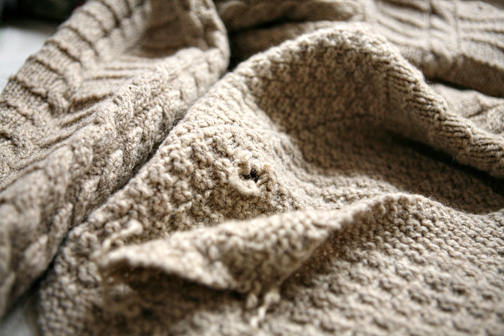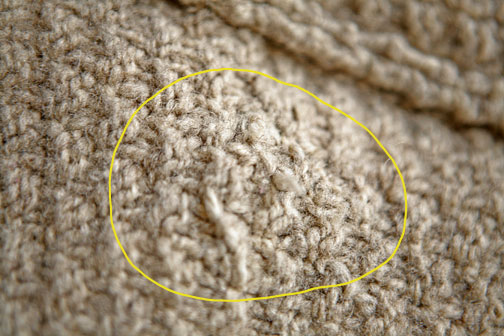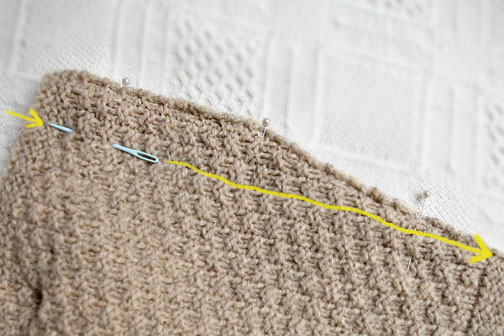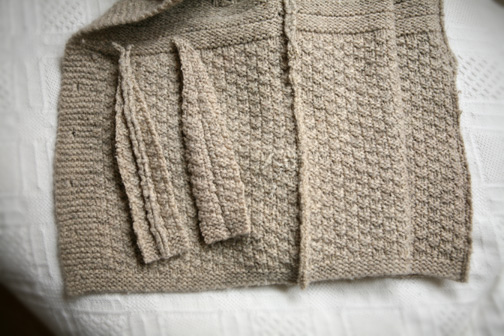Since the near zero temps are still hovering around the City, I’ve gone diving into my closet for the most likely candidate to huddle in.
It had to be:
– wool (but of course)
– dense
– long(ish)
– pretty (aw!)
Number one with a bullet was a Fair Isle alpaca number that I DID NOT KNIT (shocking!) but got years ago at the Andersonville Midsommarfest. A husband-wife team travels to So. AM and brings back sweaters and caps and when I saw it in their lovely booth, I had to have it. It is doubly warm and toasty from all the stranded action of the fair isle patterning (don’t laugh at the model in this picture!)
But I, diva of the wardrobe (packrat), must certainly have more than one candidate for the deep freeze and indeed, I came up with, hmm, several.
The one I really wanted to wear was in a basket hidden away on top of the armoire that holds my hand knits. It was the original sample for the Mrs. CB Camp jacket, a release from awhile back, made from a dense wool from a small farm called Sheepy Valley. Why was it neglected? It was too big for me and it seems to be standard procedure over here to simply abandon the ill-fit and keep them for years (packrat).
Being wonderfully wooly, thick and sporting some really pretty buttons made it really an attractive candidate for not only the cold but for one of my other favorite hobbies.
SWEATER RE-ANIMATION
I’ve been sewing and tailoring knitted stuff off and on over the years and this one was a good candidate for that because the yarn it’s made from is very grabby, in the same way fiber that would steek successfully is.
|
the Rub |
This sweater fit OK through the shoulders but was too big at the hem. So it was also a good candidate for a simple seaming session where the excess size was removed from the body of the sweater. The front pockets, which were sewn on, would have to be un-seamed for a few inches to get clear access to the new seam line. Simple, right? But me, being me, did what I always seem to do: I tugged and pulled on what looked like the seam thread, clipped, and was left with:
indeed, my now traditional, gaping hole. |
|
|
|
|
Fixit |
But since this garment is made from such fuzzy-wuzzy barn yarn, it was the perfect candidate for a simple fixit. I’m including this step just in case you find yourself in this predicament…
The Simple Solution: attach a strand of leftover yarn to the area under the hole and darn together using the Duplicate Stitch technique. My hole was a simple unravel of a row, so I could just fuse the bottom to the top. (Here’s a more detailed tutorial for a bigger hole, but uses the same principles). |
|
|
|
|
Prepare |
Now that my hole is history, I flipped the sweater inside out and marked where I as going to remove the excess fabric.
I like to use corsage pins to hold the pieces together, and I used a darning needle to mark the point where I’d begin. This is a pretty lazy approach – but then again, this is grabby yarn and there is going to be minimum slippage of the work when it goes under the presser foot of the machine. For the more faint-hearted, basting the pieces together holds them in place and makes a wonderful line to sew on. |
|
|
|
|
Seam |
I sewed up the side of the sweater, alongside the edge of a pattern group, then merged into the body of the piece right at the waist. Regular sewing thread was used in the largest stitch size my ancient machine offered.
Then, I sewed another line, about 1/8" away from the first. |
|
|
|
|
Payoff |
And here’s the fun result:
I trimmed the excess from the sides about 1/8" away from the second seam line. From l. to r.: Trimmed flaps, wrong-side, then right-side; top view of seam; side view of seam at far right. A blast from ye olde steam iron "sets" the new fibers and makes them all shake hands… |
|
|
|







You’ve got courage, woman! Great tutorial. Enjoy the rejuvenated sweater!
Easy peasy! did similar to an angora vest which I knit in the oversized ’80’s!! slim and trim now and worn a lot :)
Beautiful! You should model it for us! :-)